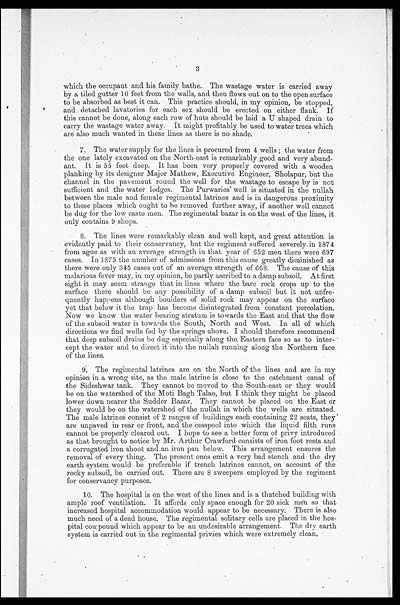Medicine - Institutions > Army health reports and medical documents > Reports on military cantonments and civil stations in the Presidency of Bombay inspected by the Sanitary Commissioner in the years 1875 and 1876 > Part I [i.e. 1] - Reports on military cantonments inspected in 1876
(63) Page 3
Download files
Individual page:
Thumbnail gallery: Grid view | List view

3
which the occupant and his family bathe. The wastage water is carried away
by a tiled gutter 10 feet from the walls, and then flows out on to the open surface
to be absorbed as best it can. This practice should, in my opinion, be stopped,
and detached lavatories for each sex should be erected on either flank. If
this cannot be done, along each row of huts should be laid a U shaped drain to
carry the wastage water away. It might profitably be used to water trees which
are also much wanted in these lines as there is no shade.
7. The water supply for the lines is procured from 4 wells; the water from
the one lately excavated on the North-east is remarkably good and very abund-
ant. It is 55 feet deep. It has been very properly covered with a wooden
planking by its designer Major Mathew, Executive Engineer, Sholapur, but the
channel in the pavement round the well for the wastage to escape by is not
sufficient and the water lodges. The Purwaries' well is situated in the nullah
between the male and female regimental latrines and is in dangerous proximity
to these places which ought to be removed further away, if another well cannot
be dug for the low caste men. The regimental bazar is on the west of the lines, it
only contains 9 shops.
8. The lines were remarkably clean and well kept, and great attention is
evidently paid to their conservancy, but the regiment suffered severely in 1874
from ague as with an average strength in that year of 652 men there were 697
cases. In 1875 the number of admissions from this cause greatly diminished as
there were only 345 cases out of an average strength of 668. The cause of this
malarious fever may, in my opinion, be partly ascribed to a damp subsoil. At first
sight it may seem strange that in lines where the bare rock crops up to the
surface there should be any possibility of a damp subsoil but it not unfre-
quently happens although boulders of solid rock may appear on the surface
yet that below it the trap has become disintegrated from constant percolation.
Now we know the water bearing stratum is towards the East and that the flow
of the subsoil water is towards the South, North and West. In all of which
directions we find wells fed by the springs above. I should therefore recommend
that deep subsoil drains be dug especially along the. Eastern face so as to inter-
cept the water and to direct it into the nullah running along the Northern face
of the lines.
9. The regimental latrines are on the North of the lines and are in my
opinion in a wrong site, as the male latrine is close to the catchment canal of
the Sideshwar tank. They cannot be moved to the South-east or they would
be on the watershed of the Moti Bagh Talao, but I think they might be placed
lower down nearer the Sudder Bazar. They cannot be placed on the East or
they would be on the watershed of the nullah in which the wells are situated.
The male latrines consist of 2 ranges of buildings each containing 22 seats, they
are unpaved in rear or front, and the cesspool into which the liquid filth runs
cannot be properly cleared out. I hope to see a better form of privy introduced
as that brought to notice by Mr. Arthur Crawford consists of iron foot rests and
a corrugated iron shoot and an iron pan below. This arrangement ensures the
removal of every thing. The present ones emit a very bad stench and the dry
earth system would be preferable if trench latrines cannot, on account of the
rocky subsoil, be carried out. There are 8 sweepers employed by the regiment
for conservancy purposes.
10. The hospital is on the west of the lines and is a thatched building with
ample roof ventilation. It affords only space enough for 20 sick men so that
increased hospital accommodation would appear to be necessary. There is also
much need of a dead house. The regimental solitary cells are placed in the hos-
pital compound which appear to be an undesirable arrangement. The dry earth
system is carried out in the regimental privies which were extremely clean.
Set display mode to: Large image | Zoom image | Transcription
Images and transcriptions on this page, including medium image downloads, may be used under the Creative Commons Attribution 4.0 International Licence unless otherwise stated. ![]()
| Permanent URL | https://digital.nls.uk/75008643 |
|---|




